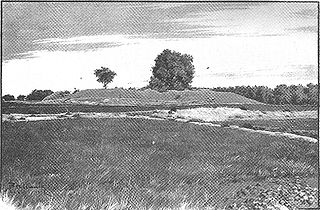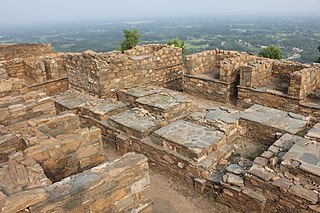
Taxila is an important archaeological site located in the modern city with the same name in Punjab, Pakistan. It lies about 32 km (20 mi) north-west of Islamabad and Rawalpindi, just off the famous Grand Trunk Road.

Vikramashila was one of the two most important centres of learning in India during the Pala Empire, along with Nalanda. Its location is now the site of Antichak village, Bhagalpur district in Bihar.

Takht-i-Bahi, commonly mispronounced as Takht-i-Bhai, is an Indo-Parthian archaeological site of an ancient Buddhist monastery in Mardan, Khyber-Pakhtunkhwa, Pakistan. The site is considered among the most imposing relics of Buddhism in all of Gandhara, and has been "exceptionally well-preserved."

The Kanishka stupa was a monumental stupa established by the Kushan king Kanishka during the 2nd century CE in today's Shaji-ki-Dheri on the outskirts of Peshawar, Pakistan.

The Dharmarajika Stupa, also referred to as the Great Stupa of Taxila, is a Buddhist stupa near Taxila, Pakistan. It dates from the 2nd century CE, and was built to house small bone fragments of the Buddha. The stupa, along with the large monastic complex that later developed around it, forms part of the Ruins of Taxila - which were inscribed as a UNESCO World Heritage Site in 1980.

Buddhism in Pakistan took root some 2,300 years ago under the Mauryan king Ashoka. Buddhism has played a major role in the history of Pakistan — the land of which over time has been part of predominantly Buddhist empires such as the Indo-Greek Kingdom, the Kushan Empire, the Maurya Empire of Ashoka, the Pala Empire.

Pushpagiri was an ancient Buddhist mahavihara located atop Langudi Hill in Jajpur district of Odisha, India. The complex contains ruins of stupas, rock-cut sculptures and other artifacts.

Mohra Muradu is the place of an ancient Buddhist stupa and monastery near the ruins of Taxila, in the Punjab province of Pakistan. The ancient monastery is located in a valley and offers a beautiful view of the surrounding mountains. The monks could meditate in all stillness at this place but were near enough to the city of Sirsukh to go for begging as it is only around 1.5 km away.

Jaulian is a ruined Buddhist monastery dating from the 2nd century CE, located in Pakistan. Jaulian is located in Haripur District, Khyber Pakhtunkhwa province, near the provincial border with Punjab and the city of Taxila.

Kanaganahalli is about 3 km from Sannati. An important Buddhist site, the place where an ancient Buddhist Mahastupa site found. It is on the left bank of the Bhima river in Chitapur taluk, Gulbarga District in Karnataka, India. Nalwar is the nearest Railway station about 19 km from Kanaganahalli. The Buddhist site about 2.5 km from Chandrala Parameshwari temple of Sannati.

Ranigat is a collection of 2nd century CE Buddhist ruins spread over an area of 4 square kilometers which dates from the Gandhara civilization. Ranigat is located in valley Buner of Pakistan's Khyber Pakhtunkhwa province.

Udayagiri (ଉଦୟଗିରି) is the largest Buddhist complex in the Indian state of Odisha. It is composed of major stupas and monasteries (viharas). Together with the nearby complexes of Lalitgiri and Ratnagiri, it is part of Puspagiri University. The heritage sites are also known collectively as the "Diamond Triangle" of the "Ratnagiri-Udayagiri-Lalitgiri" complex. Per epigraphical artifacts found at the site, its historical name was "Madhavapura Mahavihara." This Buddhist complex, preceded by the Ratnagiri and Lalitgiri sites, with their monasteries, is believed to have been active between the 7th and the 12th centuries.

Shalban vihara is an archaeological site in Mainamati, Comilla, Bangladesh. The ruins are in the middle of the Lalmai hills ridge, and these are of a 7th-century Paharpur-style Buddhist viharas with 115 cells for monks. It operated through the 12th century.

Bavikonda Buddhist Complex lies about 16 km from Visakhapatnam, in the Indian state of Andhra Pradesh, on a hill about 130 metres above mean sea level. The term Bavikonda in Telugu means a hill of wells. As per its name, Bavikonda is a hill which has wells for the collection of rainwater. Bavikonda Monastery dates back to the 3rd century BCE.

Jamal Garhi is a small town located 13 kilometers from Mardan at Katlang-Mardan road in Khyber Pakhtunkhwa province in northern Pakistan. Jamal Garhi was a Buddhist monastery from the first until the fifth century AD at a time when Buddhism flourished in this part of the Indian subcontinent. There is a beautiful monastery and main stupa, surrounded by chapels closely packed together. The site is called ‘The Jamal Garhi Kandarat or Kafiro Kote’ by the locals.

Moghalmari or Mogolmari is a village and an archaeological excavation site in the Paschim Medinipur district of West Bengal. The excavation of the site which began in 2002-03, led by Professor Asok Datta of Calcutta University has revealed the presence of a Buddhist monastery dated between 6th to 12th Century. A detailed excavation of the site started in November 2013 by the State Archaeological Directorate led to discovery of several artifacts and six tablets.

Sanchi Town is a Nagar panchayat in Raisen District of the state of Madhya Pradesh, India, it is located 46 km north east of Bhopal, and 10 km from Besnagar or Vidisha in the central part of the state of Madhya Pradesh. Known for its "Sanchi Stupas", it is the location of several Buddhist monuments dating from the 3rd century BC to the 12th CE and is one of the important places of Buddhist pilgrimage.

Bhamala Stupa is a ruined Buddhist stupa and National Heritage Site near Haripur, Pakistan that dates to the 2nd century CE. It is located on the bank of Haro River, a tributary of a Khanpur Dam, and is a tourist destination. Bhamala stupa is part of the larger Bhamala Buddhist Complex. The site is known for its 1,700 year old statue of the Buddha attaining enlightenment - considered the oldest such statue in the world.

Chandavaram Buddhist site is an ancient Buddhist site in Chandavaram village in Prakasam district in the Indian state of Andhra Pradesh. Situated on the bank of Gundlakamma River, the site is 10 kilometres (6.2 mi) northwest of Donakonda railway station. The Chandavaram Buddhist site was built between the 2nd century BCE and the 2nd century CE during the Satavahana dynasty and was discovered by Dr. Veluri Venkata Krishna Sastry in 1964.

Gandhāran Buddhism refers to the Buddhist culture of ancient Gandhāra which was a major center of Buddhism in the Indian subcontinent from the 3rd century BCE to approximately 1200 CE. Ancient Gandhāra corresponds to modern day north Pakistan, mainly the Peshawar valley and Potohar plateau as well as Afghanistan's Jalalabad. The region has yielded the Gandhāran Buddhist texts written in Gāndhārī Prakrit the oldest Buddhist manuscripts yet discovered. Gandhāra was also home to a unique Buddhist artistic and architectural culture which blended elements from Indian, Hellenistic, Roman and Parthian art. Buddhist Gandhāra was also influential as the gateway through which Buddhism spread to Central Asia and China.
























